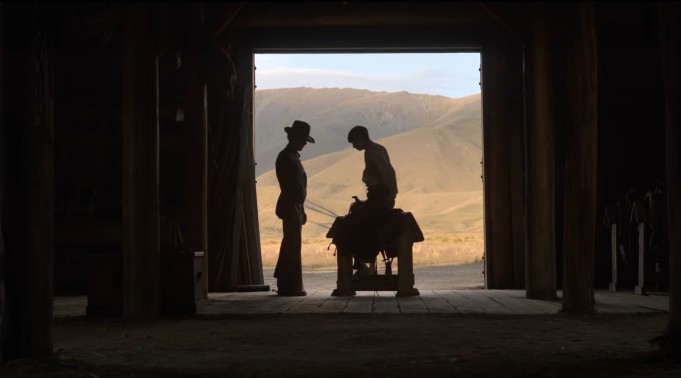Proving her filmmaking really is the dog's bollocks, Jane Campion has concocted a perfect film.
-
10
The closing shot of The Searchers is the most famous and influential shot in the Western genre, as John Wayne is framed to perpetual loneliness by the rectangle of a door frame. The Power of the Dog updates the shot very early on into a triptych one: Benedict Cumberbatch’s Phil Burbank prowls between the frame of a window as the camera slides to the left, catching his movement through a second window before sliding to the final window and mapping his lone movement for a final time. This stylish sequence is but one way that director Jane Campion brings her unique voice to the Western genre with Netflix’s latest awards offering.

New Zealand Film Commission
The Power of the Dog, an adaptation of the 1967 novel of the same name, is a magnetic narrative that unfolds with the slow but methodical movement of a toy maze that rolls a small metal ball towards the middle where it finally rests, complete. Phil Burbank is a wealthy rancher who works with his brother, Jesse Plemon’s George. Whilst herding cattle, George meets and falls in love with Rose (Kirsten Dunst), who has a son, Peter (Kodi Smit-McPhee). Perturbed by this, Phil antagonises the two with unnerving psychological abuse that rattles Rose to alcoholism. Cumberbatch is always good, these are facts. But here is a performance worthy of accolades; he dominates the screen in both close-ups and wides, dishing out insults, whistling a chilling tune and strumming away on his banjo. Early on he observes the effeminate actions of Peter, in particular his floral napkins, and ruthlessly burns one to ignite his cigarette. It is a degrading moment for Peter and sets in motion the fear Rose has for Phil.
Jane Campion directs with surgical precision. The atmosphere is fragile with the threat of violence hanging over them like a sagging branch. But unlike the firefights that end most Westerns, Campion omits Winchester rifles and six-shooters, rendering The Power of the Dog a boiling kettle that never boils. The story is largely confined to the Burbanks’ ranch, but Campion’s camera oozes creativity, emoting as much as her performers do. A mercurial conversation between Phil and George, separated by a rich, brown staircase, is a masterclass in blocking and camera work. Emerging from the first-floor shadows, Phil slowly saunters down, lighting a cigarette as he gets nearer to his sitting, almost incapacitated brother. Each time Campion cuts back to George, the camera pushes in more, trapping him in unease until Phil reaches the bottom whereby George begins a swift ascent. It is a fine example of why Campion should bag her Best Director Oscar this year.
/cdn.vox-cdn.com/uploads/chorus_image/image/70187163/TPOTD_KS_0055.0.jpg)
New Zealand Film Commission
Creating a ‘new’ western frontier is largely due to Campion’s eye for subtle details and exquisite character work, but the New Zealand landscape, specifically the Otago region, is a notable, refreshing aspect. The scenery is terrific; clusters of jagged rocks form the teeth of the ‘American’ prairie and the rolling hills and mountains loom in the background of a cute dancing scene. It is an identity far removed from the endless deserts or golden plains of Texas or Kansas, and serves to reiterate that every genre can be refreshed, no matter how stale it may seem.
As Phil stares intently at a local hill, another rider asks “there is something there, right?” Phil is quick to reply: “not if you can’t see it there ain’t.” For some, this film may seem unrewarding, too subtle and anti-climatic. But for those like Phil, there is an astounding amount of depth to this production.
The Power of the Dog is available in select cinemas and on Netflix now with a 12A certificate. Watch the trailer below:




